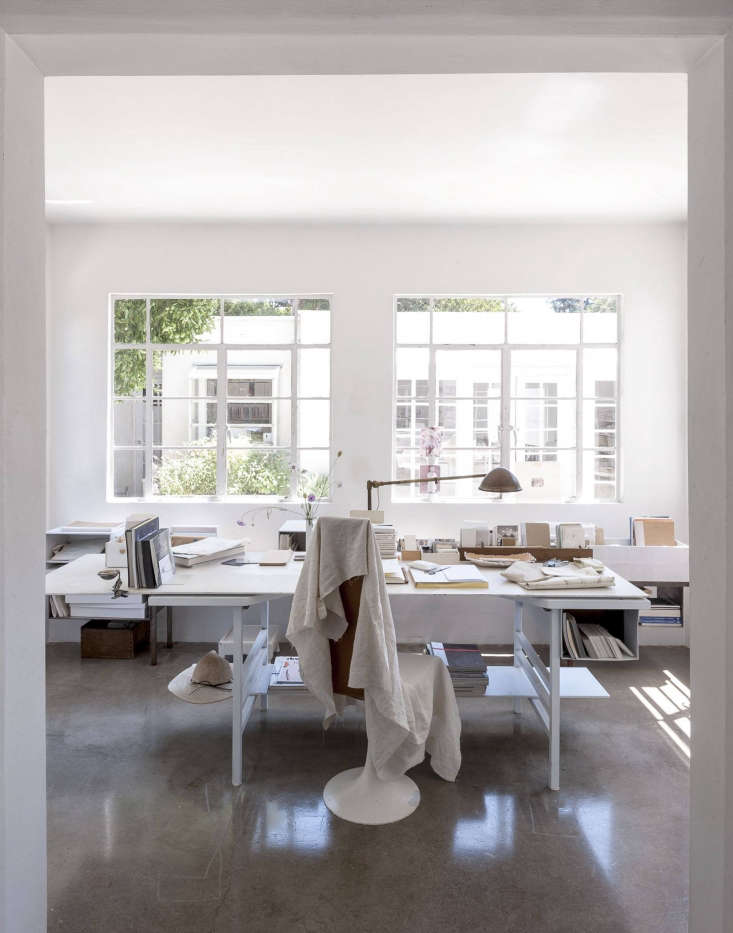When setting up a home office, most people focus on the big-purchase items—the desk, chair, and filing system. Lighting often comes as an afterthought—and yet, poor lighting can cause eyestrain and headaches, and is definitely not a mood enhancer. Attention, fellow workaholics: Considering the high percentage of time we spend toiling, it makes sense to create a setting with optimal lighting. Here’s what you need to know.

1. What’s the general strategy for lighting a home office?
Lighting a home office is akin to dressing for a climate with changeable weather: It’s all about layering. When you consider the range of activities that go on in workspaces—reading, filing, working at a computer, talking on the phone, holding meetings—you realize that most are focus-intensive tasks that can’t be well-lit by one light source alone. Instead, start by illuminating your office with an even and soothing warm, ambient light. It’s ideal to place your ambient lights on a dimmer switch, so you have the flexibility to adjust light levels depending on the time of day and type of work you’re doing. Supplement this central source with task lamps on the desk and other key spots.


2. What’s the role of the task lamp?

Task lights provide a focused light source on specific activities. If a range of activities takes place in your office, it’s best to have a dedicated task light for each. Adjustable arms are ideal for accommodating a range of setups. See 10 Easy Pieces: Industrial-Style Desk Lamps, Color Edition for our picks.
3. Why is the placement of the light source important?

Where you place your lights is critical in avoiding glare and shadows. For instance, an overhead spotlight situated behind you can result in glare on your computer screen. To avoid shadows created by task lamps, place the light on the side opposite from the hand that you write with—if it’s on the same side, your hand and arm will cast shadows.
4. What about natural daylight?

Natural light improves the ambience of any room, which, in turn, helps enhance focus and productivity—Julie has noticed that her whole family likes to work in the living room because it’s so sunny. In some rooms, however—such as my own home office—at certain times of day, direct sunlight can create an overwhelming glare. You can mitigate this by installing simple translucent blinds. If there’s a window in your home office and you’re working at a computer, the best position for the computer is on a desk that’s perpendicular to the window. Placing your computer in front of the window can cause stress to your eyes because the brightness from behind may create too much of a contrast.
5. How can lighting alleviate the effects of working at a computer all day?

Minimizing glare and contrast is the key to reducing eye strain. Harsh artificial or natural light is what creates the monitor glare that tires our eyes. Having your lights on dimmers and hanging light-diffusing blinds in your windows allows you to modulate light levels throughout the day, depending on the time of day and task at hand. It’s important to note that paperwork activities require a higher light level than computer work, which means that most of us when at our computers ought to consider turning down the ambient and task lighting.
Home Office Lighting Recap:
- One overall source of lighting is not enough to accommodate the varied activities of a home office; it’s best to layer light sources.
- Use task lamps to illuminate focused work.
- The correct placement of a task light is important to avoid glare and shadows.
- Natural daylight improves the ambience of a room, but at certain times of day can be too bright.
- Being able to adjust light levels throughout the day is ideal for the eyes and promotes productivity.
For more lighting advice, see our posts:
- How to Install Flattering Lighting in the Bathroom
- 10 Easy Pieces: Basic Porcelain/Glass Ceiling Lights Under $200
- Remodeling 101: Smart Light Bulbs
N.B.: This post is an update; the original story ran May 15, 2014.





Have a Question or Comment About This Post?
Join the conversation (2)